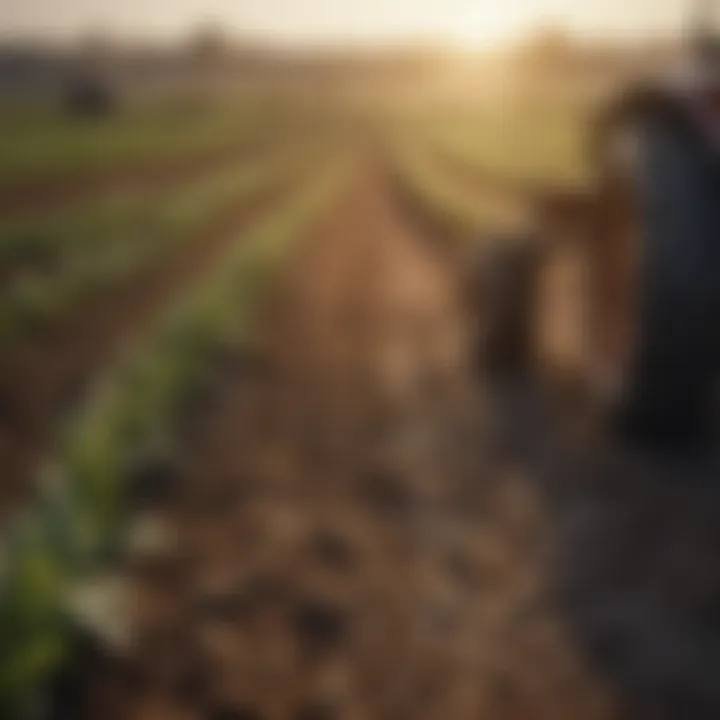Innovative Strategies in Agriculture Product Development


Overview of the Topic
Agriculture product development plays a crucial role in the evolution of farming. It involves creating new goods or improving existing ones to boost efficiency, yield, and sustainability. Understanding this field is essential for all stakeholders in agriculture.
Definition and Importance
At its core, agriculture product development refers to the research, creation, and enhancement of agricultural products. This can include seeds, fertilizers, pesticides, and even technologies. The importance of this field lies in its potential to increase food security, adapt to climate change, and satisfy the growing demand for food. In a world facing rapid population growth and environmental challenges, effective product development can make a significant difference.
Current Trends
Several current trends shape the landscape of agricultural product development. These include:
- Emphasis on Sustainability: There is a strong focus on sustainable practices that minimize environmental impact. This is driven by consumer demand for eco-friendly products and the need to conserve resources.
- Technological Integration: Advances in technology, such as precision agriculture and biotechnology, are at the forefront of product innovation. Techniques such as genetic modification and data analytics are becoming commonplace.
- Collaborative Approaches: Stakeholders now prioritize collaboration across the industry. This includes partnerships between governments, research institutions, and private companies.
"Agricultural product development is not just about innovation; it is about ensuring the future of food security and environmental stability."
Key Techniques and Practices
In agriculture product development, certain techniques and practices stand out as particularly effective.
Step-by-Step Guide
- Identify Needs: Understand the specific needs of farmers and consumers. This includes researching market trends and gaps in current product offerings.
- Conduct R&D: Engage in robust research and development to create or improve products. This often involves experimenting with various formulations or technologies.
- Prototype Testing: Develop prototypes and conduct field tests to gauge performance under real-world conditions.
- Gather Feedback: Solicit feedback from end-users, such as farmers, which can provide valuable insights into product effectiveness.
- Launch and Monitor: Introduce the final product to the market while closely monitoring its performance and gathering ongoing feedback for future improvements.
Tools and Equipment Needed
Some essential tools include:
- Laboratory equipment for testing new products.
- Data collection tools for monitoring field performance.
- Collaboration software for communication amongst stakeholders.
Challenges and Solutions
The journey of agriculture product development is not without hurdles.
Common Obstacles
Challenges vary but often include:
- Regulatory Hurdles: Navigating complex regulations can slow down the approval process for new agricultural products.
- Market Resistance: Farmers and consumers can be resistant to adopting new products, often due to lack of information or trust.
- High Research Costs: Significant investment in R&D is often necessary, which could deter smaller companies from entering the market.
Innovative Solutions
To deal with these challenges, innovative solutions can include:
- Education Campaigns: Engaging in outreach efforts can build trust and inform farmers about the benefits of new products.
- Streamlining Processes: Collaborating with regulatory bodies to simplify and accelerate approval processes.
- Public-Private Partnerships: Encouraging partnerships can help share the financial burden of research and overcome market barriers.
Prelude to Agriculture Product Development
Agriculture product development is pivotal for increasing efficiency and productivity within the sector. In an era marked by population growth and climate change, it becomes crucial to innovate and adapt to ensure food security. Understanding the concepts behind product development not only helps in creating better agricultural outputs but also addresses the integration of sustainability into farming practices.
Strategies employed in this field lead to improved crop varieties, better pest management, and enhanced food quality. Each of these innovations is instrumental in achieving higher yields while minimizing adverse environmental impacts. Moreover, as markets shift and consumer preferences evolve, the need for continuous product development in agriculture cannot be understated. In this context, collaboration among stakeholders, including farmers, researchers, and consumers, becomes essential.
Definition and Scope
Agriculture product development encompasses a wide range of processes aimed at creating new products or improving existing ones within agricultural systems. This includes not only the development of crops and livestock but also innovations in farming practices and technologies. The scope covers genetic improvements, sustainable farming practices, and new methodologies for pest control or water usage.
The rise of precision agriculture exemplifies this scope. It integrates advanced technologies into farming, allowing for data-driven decisions that enhance crop performance and resource management. Thus, the definition is broad, linking numerous disciplines, including biology, environmental science, and technology, to formulate practical solutions for modern farming needs.
Historical Context
Historically, agriculture has witnessed several transformations, many of which have contributed to product development. From the early domestication of plants and animals to the Green Revolution of the 20th century, the field has evolved significantly. Innovations such as hybrid crops and synthetic fertilizers greatly improved yield and food production capacity. However, these advances did not come without challenges, as issues related to ecological balance and soil degradation emerged.
In more recent decades, there has been a noticeable shift towards sustainable practices. This includes organic farming and the exploration of biotechnology, which aim to develop products that are both productive and environmentally friendly. By learning from the past, current agricultural product development seeks to integrate technological advancements with sustainable methods, creating a balanced approach that meets today’s demands.
The Role of Research and Development
Research and Development (R&D) plays a critical role in the field of agriculture product development. It is essential for fostering innovation and driving advancements in agricultural practices. By focusing on R&D, agricultural stakeholders can devise effective strategies to enhance productivity, manage resources effectively, and adapt to changing environmental conditions. The interplay of R&D with market demands and sustainability concerns also forms a vital part of modern agriculture.
Innovative approaches brought forth through R&D can significantly improve crop yields, reduce costs, and address nutrient management challenges. Understanding the complexities of soil health, pest resistance, and crop genetics benefits greatly from rigorous research efforts. Increased agricultural output must be achieved while ensuring environmental protection, and R&D is pivotal in striking that balance.
Investments in R&
Investments in R&D are crucial for achieving progress in agriculture. Financial commitment from both the public and private sectors propels research projects that lead to new farming technologies and sustainable practices. Funding supports universities, research institutions, and agricultural companies in exploring novel solutions to pressing agricultural issues.


Additionally, the returns on investment often outweigh the costs. For example, the development of drought-resistant crop varieties from thorough research has transformed farming in many arid regions. It allows farmers to maintain productivity under adverse conditions and secures their livelihoods. Successful projects often exhibit a cycle of reinvestment, where profits from initial innovations funnel back into further research.
Some key areas where investment in R&D is imperative include:
- Genetic Improvement: Enhancing crop traits through genetic engineering to address climate stressors.
- Sustainable Practices: Developing environmentally friendly farming methods to conserve resources.
- Soil Health Research: Understanding soil biodiversity and developing strategies to maintain it.
Technological Advancements
Technological advancements are inherently linked to the effectiveness of R&D in agriculture. Innovative technologies pave the way for improved practices and productivity. In recent years, the integration of data analytics, precision farming, and biotechnology has reshaped the agricultural landscape.
Precision agriculture uses GPS and data analytics to optimize field-level management regarding crop farming. This enhances resource utilization, minimizing waste and environmental impacts. Technologies such as drones and sensors provide real-time data on crop health, allowing farmers to react promptly to potential issues.
Moreover, biotechnology advancements have enabled significant breakthroughs in disease resistance and productivity enhancements. Tools like CRISPR allow for specific modifications in plant genomes, offering rapid progress compared to traditional breeding methods.
As these technologies continue to evolve, they promise to address food security challenges, making R&D a cornerstone in meeting the needs of a growing global population. By harnessing technology through R&D, the agricultural sector can maintain a competitive edge and promote sustainable practices.
Market Dynamics in Agriculture
Understanding market dynamics is crucial in agriculture product development. It encompasses various factors that influence the buying and selling of agricultural products, including supply and demand, pricing strategies, and market trends. Recognizing these dynamics allows stakeholders to make informed decisions, ensuring resilience and adaptability in an ever-evolving sector.
Consumer Trends
Consumer preferences play a significant role in shaping agricultural products. There is a growing demand for organic and locally sourced goods, driven by increasing health awareness and environmental consciousness. Consumers are becoming more educated about their food choices, leading to shifts in purchasing behavior.
- Health Consciousness: Many consumers prefer products that are free from harmful chemicals or additives. This trend supports organic farming practices and promotes natural methods of pest control, which align with consumer health goals.
- Sustainability: Products that are marketed as environmentally friendly or sustainably sourced often gain favor among consumers. This trend influences farmers to adopt innovative practices such as permaculture or regenerative agriculture.
- Convenience: Many consumers seek products that are easy to prepare or use. This has led to an increase in ready-to-eat options, and farmers should consider packaging that enhances convenience without compromising quality.
The way consumers perceive and prioritize these factors directly impacts product development strategies. Farmers and agricultural businesses should continuously monitor these trends to effectively meet market demands.
Competitive Landscape
The competitive landscape within agriculture is shaped by numerous factors, including the number of players in the market, product diversity, and innovation. Understanding how these elements interact can help businesses position themselves effectively.
- Market Entry: New entrants can disrupt established dynamics, offering innovative solutions or niche products. Farmers must identify their unique selling proposition to stand out in a crowded marketplace.
- Technological Adoption: Farmers who leverage technology, such as precision agriculture or biotechnology, can gain a competitive edge. This allows for improved yield, better resource management, and a strong appeal to tech-savvy consumers.
- Pricing Strategies: Competition often drives down prices, requiring farmers to find a balance between sustainable profitability and market prices. Employing strategies such as value-added products can help navigate this challenge.
Knowing the competitive landscape helps agricultural producers to adapt their strategies and innovate continually. As market conditions evolve, those who can anticipate trends and adapt quickly are likely to achieve lasting success.
"Staying attuned to market dynamics is not just about reacting to changes but also anticipating them for proactive strategic planning."
Sustainable Practices in Product Development
Sustainable practices in agriculture product development are essential for creating a balance between productivity and environmental stewardship. Such approaches aim not only to yield higher outputs but also to minimize adverse impacts on ecosystems. As agriculture faces challenges from climate change, dwindling resources, and growing populations, integrating sustainability is no longer just an option; it is a necessity. Sustainable practices benefit not only the environment but also the economic viability of farms, ensuring that agricultural systems remain resilient and productive for future generations.
Defining Sustainability in Agriculture
Sustainability in agriculture refers to the capacity to maintain agricultural production over time without compromising future generations' ability to meet their own needs. It involves three key pillars: economic, social, and environmental factors.
- Environmental Stewardship: This includes the care of soil, water, air, and biodiversity. Farmers can adopt methods such as crop rotation, cover cropping, and reduced chemical input to foster soil health and protect ecosystems.
- Economic Viability: Agriculture must remain profitable for producers. Sustainable practices can lead to reduced costs in the long run through resource efficiency and the use of local inputs, decreasing dependency on external inputs.
- Social Responsibility: Engaging local communities and ensuring fair labor practices is also a part of sustainability. Farmers must consider the social implications of their practices and promote inclusivity within the agricultural sector.
In summary, sustainability in agriculture is a holistic approach that harmonizes economic growth, environmental health, and social equity.
Case Studies of Sustainable Innovations
Examining real-world applications of sustainable agriculture can provide valuable insights. Various case studies illustrate how innovative practices lead to positive outcomes.
- Vertical Farming at AeroFarms: AeroFarms utilizes aeroponic technology to grow crops without soil. This method significantly reduces water usage, allowing farming in urban settings with minimal land requirements. Their approach exemplifies resource efficiency in operation.
- Soil Health Initiatives in California: Farmers in California have adopted regenerative agriculture techniques. These include no-till farming and diverse cropping systems, which improve soil fertility and biodiversity. In doing so, they have seen increased yields and resilience to drought conditions.
- Integrated Pest Management (IPM): Several growers have implemented IPM techniques that combine biological controls with limited use of chemicals. This approach enhances crop health while minimizing chemical residue.
"Sustainable innovations in agriculture are no longer niche; they represent a growing commitment to responsible farming that aligns with global sustainability goals."
These case studies highlight how sustainable practices can lead to both environmental benefits and economic resilience. By drawing on existing innovations and adapting them to local contexts, farmers can effectively embrace sustainable development.
As agricultural practices evolve, prioritizing sustainability will be vital for long-term success and food security. This emphasis on sustainability can maximize productivity while protecting vital resources contributing to our planet's health.
Integration of Technology
The integration of technology in agriculture product development is not just a trend; it is a critical element that shapes the future of the industry. The application of various technological tools enhances efficiency, increases yields, and ensures that agricultural practices are more sustainable. As stakeholders in the agricultural sector strive to meet rising global demands, technological integration emerges as a vital strategy that cannot be overlooked. The nexus between technology and agriculture is forged through precision agriculture, the Internet of Things (IoT), and data analytics, all of which serve to transform traditional farming methods into smart, reliable practices.
Precision Agriculture
Precision agriculture, often termed "smart farming," employs advanced technologies to monitor crop yields, soil conditions, and weather patterns. The use of GPS technology and remote sensing enables farmers to gather precise data regarding their fields. These insights facilitate tailored treatment for specific areas, ensuring resources such as water and fertilizers are utilized effectively.
Farmers can regulate irrigation systems with great precision, diminishing wastage of water during dry spells. This method significantly reduces operational costs while also maximizing production. According to research, implementation of precision agriculture can increase crop yields by up to 30% when combined with proper management practices.
The Internet of Things in Farming
The Internet of Things (IoT) refers to the interconnection of devices capable of sending and receiving data. When applied to farming, IoT offers real-time monitoring of crops and livestock. Smart sensors can track moisture levels, temperature, and even pest activity, allowing for immediate action to be taken before issues escalate.


For instance, a farmer employing IoT technology can access a dashboard on their smartphone, displaying real-time data from their fields. This connectivity fosters data-driven decisions, leading to better resource management and enhancing productivity over time. Moreover, with IoT, farmers can also automate many processes. This integration not only lightens labor demands but also contributes to efficiency and productivity gains.
Data Analytics in Crop Development
Data analytics plays an indispensable role in modern agriculture, guiding farmers in their decisions right from planting to harvesting. With the analysis of historical data and real-time inputs, farmers can predict crop performance and market trends with greater accuracy.
Through machine learning algorithms, farmers can identify patterns and make informed decisions about which crops to plant based on local factors such as soil quality and weather conditions. Furthermore, data analytics helps in risk assessment, enabling better forecasting of potential crop failures or market downturns.
The future of agriculture relies heavily on the effective integration of technology, enabling farmers to make smarter, timely decisions.
Challenges in Agriculture Product Development
The topic of challenges in agriculture product development holds significant importance in understanding the breadth of factors that influence success in this sphere. Addressing these challenges is crucial not only for producers but also for consumers and the environment. As global demand for food escalates, it is essential to navigate obstacles effectively to enhance productivity and sustainability. These challenges can greatly impact how innovations are integrated into agricultural practices and the overall efficacy of product development strategies.
Regulatory Hurdles
Regulatory hurdles are often a major roadblock in agriculture product development. Every country has its own set of regulations governing agricultural practices, product safety, and environmental impact. Navigating these rules can be complex and time-consuming.
- Approval Processes: Introducing a new agricultural product often requires extensive testing and data submission to regulatory bodies. This process ensures that the products are safe for consumers and the environment but can take years to complete.
- Compliance Costs: Meeting regulatory standards incurs significant costs. Small and medium-size farmers might find it particularly challenging to afford the expenses related to compliance, thus limiting their ability to innovate.
- Varied Regulations Globally: For those looking to export, the varying regulations across different regions pose additional challenges. Understanding local laws is critical and often demands resources that many may not readily have.
Overall, these regulatory hurdles can stifle innovation, limit product availability, and slow down the response to market demands.
Environmental Concerns
Environmental concerns also pose significant challenges in agriculture product development. As agriculture is inherently linked to the ecosystem, the impact of agricultural practices on the environment cannot be understated.
- Sustainability Issues: Advances in product development must consider sustainable practices. The overuse of fertilizers and pesticides can lead to soil degradation and loss of biodiversity. Therefore, products need to be developed with their long-term environmental impact in mind, not just short-term yield.
- Climate Change: Changing climate patterns affect crop production and can lead to increased variability in yields. Developers must innovate under uncertain conditions, which adds complexity to the product development process.
- Resource Availability: Water scarcity and land degradation present significant challenges. Innovations must focus on efficient resource usage and finding ways to ensure resilience in the face of these concerns.
"Innovation must not only focus on increasing yields but also on ensuring practices that protect our environment for future generations."
In summary, the challenges of regulatory hurdles and environmental concerns form a crucial component of agriculture product development. Addressing these obstacles demands a concerted effort from farmers, businesses, and policymakers to ensure sustainable and profitable agricultural practices.
Collaboration among Stakeholders
Collaboration among stakeholders in agriculture product development is critical. Stakeholders include farmers, researchers, businesses, and policymakers. When these groups work together, they bring diverse insights and resources. This synergy helps address complex challenges in agriculture. The benefits of collaboration are many and significant.
Key Benefits of Collaboration:
- Enhanced Innovation: Collaborative efforts can lead to innovative solutions. Research teams can work with farmers to test new products in real-life settings. This can speed up the development process and result in more effective products.
- Shared Resources: Stakeholders can share knowledge and resources. For example, a research facility may provide data, while farmers offer local insights. This exchange can lead to better-informed decisions and minimize risks.
- Better Market Understanding: By collaborating with market experts, stakeholders can better understand consumer needs and preferences. This understanding leads to products that are more likely to succeed in the marketplace.
However, certain considerations are important in this collaboration. Clear communication is essential. Misunderstandings can lead to failure in projects. Setting clear goals and understanding each stakeholder's role can enhance collaboration outcomes.
Moreover, the willingness to engage in dialogues about challenges enhances trust. All parties need to feel their input is valued. In agriculture, this dialogue is especially important due to the multifaceted nature of the sector.
Collaboration is not just about pooling resources; it's about fostering relationships. As Bob Watson, former chief scientist at the UK government's Department for Environment, Food and Rural Affairs, stated:
"To accomplish a common goal, we must work together, bringing various strengths to the table."
In summary, effective collaboration among stakeholders is vital. It not only facilitates innovation and market understanding, but it also lays the foundation for sustainable agricultural practices.
Partnerships in the Agricultural Sector
Partnerships in the agricultural sector take many forms. They can range from formal alliances to informal collaborations. These partnerships are important as they can drive successful product development.
Farmers often collaborate with universities and research institutions. Through these partnerships, farmers gain access to cutting-edge research and new agricultural technologies. Moreover, businesses can establish partnerships with farms to develop tailored products that meet market demands. This close collaboration helps to ensure product relevance and market acceptance.
Some common types of partnerships include:
- Public-Private Partnerships: Collaborations between government bodies and businesses can lead to large-scale agricultural projects.
- Non-Governmental Organizations: NGOs often partner with farmers to promote sustainable practices, which can benefit both community and environment.
The agricultural landscape is changing rapidly. Partnerships can be a powerful tool to adapt to these changes.
Role of Government and Policy Makers
Governments and policymakers play a pivotal role in agriculture product development. They create policies that shape research, funding, and the general environment in which agriculture operates.
Importance of Government Involvement:
- Regulatory Frameworks: Policymakers establish regulations that govern agricultural practices. Clear, flexible regulations can promote innovation by providing guidelines that support research and development.
- Funding Opportunities: Government funding can substantially aid R&D initiatives. Financial grants or subsidies can lower the risk associated with product development.
- Infrastructure Development: Investments in infrastructure, such as irrigation systems and transport, support agricultural efficiency and product movement.
Engagement between farmers and government is critical. Open lines of communication allow for input on policies that affect agriculture products. Often, farmers provide insights that can help shape regulations.
Ultimately, the role of government and policymakers is to create a fertile ground for product development. When collaboration among stakeholders occurs, agricultural innovation can flourish.


Product Lifecycle Management in Agriculture
Product lifecycle management (PLM) serves as a critical framework in agriculture product development. It encompasses the entire life span of a product, from conception to market exit. Effective PLM can streamline processes, improving efficiency and productivity in the agricultural sector.
The importance of PLM lies in its capability to integrate various functions of product development. By managing stages systematically, stakeholders can adapt and respond to market demands. This organization helps in optimizing resources and reducing time to market, which is vital in a sector that deals with perishable goods.
Benefits of Effective Product Lifecycle Management:
- Resource Optimization: PLM allows for better allocation of resources, reducing waste.
- Enhanced Productivity: By focusing on each stage, agricultural firms can boost yield.
- Market Responsiveness: Quick adaptations to trends lead to a competitive advantage.
- Sustainability: Proper management can help to create environmentally friendly practices.
Considerations about PLM include the need for collaboration among various stakeholders. This integration often involves farmers, research institutions, and technology providers to ensure a holistic approach to product development, leading to innovative solutions in agriculture.
Stages of Product Development
The stages of product development are pivotal in PLM. They encompass a series of actions taken to bring a new agricultural product to market. Typically, these stages include:
- Ideation: Identifying market needs and generating ideas for new products.
- Research: Conducting studies to validate the feasibility and potential success of the concept.
- Development: Creating prototypes and testing them to refine the product.
- Launch: Introducing the product to the market with effective marketing strategies.
- Review: Assessing the product's performance and making necessary adjustments.
Each of these stages plays a role in ensuring that the product is viable and successful, addressing consumer needs while maintaining sustainability.
Evaluation and Feedback Mechanisms
Evaluation and feedback mechanisms are essential in maintaining the effectiveness of product lifecycle management. They provide insights into the product’s performance post-launch and guide future developments.
Key Components of Evaluation and Feedback:
- Performance Metrics: Tracking sales, customer satisfaction, and market share.
- Consumer Feedback: Gathering insights from customers to identify needed improvements or adjustments.
- Market Analysis: Continuously monitoring the competitive landscape to adapt strategies as required.
"Constant feedback loops allow for an agile approach to product management, crucial for adapting to changing market dynamics."
By incorporating these mechanisms, agricultural businesses can make informed decisions that lead to innovation and improved agricultural practices, ultimately contributing to the long-term sustainability of the sector.
Emerging Trends in Agriculture Product Development
Emerging trends in agriculture product development are crucial for shaping the future of the industry. They reflect innovations that can significantly enhance productivity and sustainability. With the world facing challenges such as climate change and population growth, understanding these trends becomes even more important. Farmers and agribusinesses must stay informed about the latest developments to remain competitive and responsive to market demands.
Vertical Farming Solutions
Vertical farming is revolutionizing the way we think about agricultural production. This method maximizes space by growing crops in stacked layers, often within controlled indoor environments. The benefits are numerous. For one, vertical farming reduces the need for pesticides and minimizes water usage. Traditional farming requires extensive land and often faces issues such as soil degradation and weather dependency. In contrast, vertical farms can be set up in urban areas, thus reducing transportation costs and emissions.
Key aspects of vertical farming include:
- Efficiency: Utilizing advanced technologies like hydroponics and aquaponics allows crops to grow faster than in soil.
- Year-Round Production: Controlled environments ensure crops can be produced regardless of external conditions, leading to increased yield.
- Resource Management: Vertical farms often use less water than traditional farming methods.
However, it’s important to consider the initial investment and energy costs associated with running these farms. Sustainability assessments should accompany the planning phases to ensure that the benefits outweigh the drawbacks.
Biotechnology Developments
Biotechnology continues to be a significant pillar in agriculture product development. Innovations such as genetic modification and CRISPR technology enable the improvement of crop resilience against pests and climate stress. More specifically, developing crops that can withstand drought or extreme temperatures presents a promising avenue for increasing food security.
Some notable biotechnological advancements include:
- Improved Crop Varieties: Genetic engineering can enhance yield and nutritional quality.
- Disease Resistance: Plants engineered to resist specific pathogens can reduce the need for chemical inputs, promoting a healthier ecosystem.
- Sustainability: Biotech solutions can lead to reduced greenhouse gas emissions through optimized farming practices.
Nonetheless, there are significant considerations to keep in mind. Public perception of genetically modified organisms (GMOs) varies, and consumer acceptance remains a topic of discussion. It is vital for developers to engage with stakeholders to ensure transparent communication about the benefits and risks of biotechnological advancements.
"Emerging agricultural technologies not only seek to enhance productivity but also aim for sustainability, ensuring food security for future generations."
The Future of Agriculture Product Development
The exploration of the future of agriculture product development is essential in understanding how the sector can evolve to meet growing demands and sustainability challenges. As the global population increases, so does the urgency for innovative solutions that enhance agricultural productivity while minimizing environmental impacts. The interplay of technology, research, and collaborative efforts among stakeholders will shape this future.
Innovations on the Horizon
New technologies are on the verge of revolutionizing agriculture product development. Developments such as genetic engineering, artificial intelligence, and advanced sensors will usher in a new era of farming.
- Genetic Engineering: Emerging techniques like CRISPR enable precise modification of plant and animal genes. This can result in crops that are more resilient to climate change and pests, effectively increasing yield and reducing reliance on chemical inputs.
- Artificial Intelligence: AI can analyze vast datasets to provide insights into weather patterns, soil health, and crop performance. This enables farmers to make informed decisions and optimize their practices.
- Advanced Sensors: Sensors in the field can monitor various crop health indicators. This real-time data allows for timely interventions which improve both yield and sustainability.
Innovations in these areas offer substantial potential to transform agriculture, providing solutions that align with both market demands and environmental considerations.
Impact on Global Food Security
The advancements in agriculture product development directly influence global food security, which remains a critical issue worldwide. As populations grow and arable land decreases, efficient agricultural practices become vital to sustain food supplies.
- Increased Efficiency: With innovations improving yield and reducing waste, farmers will be better equipped to meet the nutritional needs of an expanding global population.
- Resilience to Climate Change: Developing crops that can withstand extreme weather events is crucial. Innovations help adapt agriculture to changing climatic conditions, ensuring a stable food supply.
- Sustainable Practices: With a focus on sustainability, future agricultural methods aim for minimal environmental impact. Sustainable practices reduce soil degradation and water usage, contributing to long-term food security.
By embracing a forward-looking approach in agriculture product development, the industry can not only enhance production but also ensure that resources are managed wisely for future generations.
"Innovation in agriculture is no longer optional. It's a necessity for future food security."
For more in-depth information on these topics, you can refer to Wikipedia, Britannica or discussions on Reddit.



